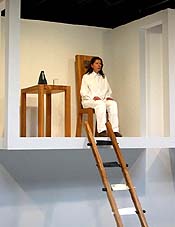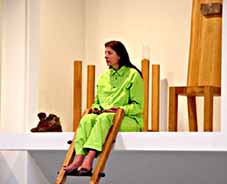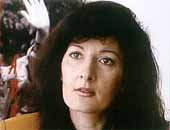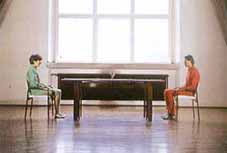PERFORMING THE PRESENT TENSE
by Thomas McEvilley

For nearly two weeks last November, Marina Abramovic lived on a kind of stage set at New York’s Sean Kelly Gallery. The elegantly minimalist structure of drywall and wood, attached to the rear wall of the main space, was like three adjacent balconies of a hotel overlooking the seaside. (The piece was called The House with the Ocean View.) These balconies were partly open on the sides and separated from one another by about 18 inches, so Abramovic could step from one to the next, though it was a slightly long step. The balcony on the viewer’s left was a bathroom, with a shower, a toilet and a bucket used to flush the toilet--- none of which was curtained off from the audience’s gaze. The balcony in the middle was a living room with a table, a chair and a water glass. To the right was a bedroom, including a wooden-box bed with no mattress, over which a water faucet and a basin hung from the wall. A telescope was installed in the gallery to facilitate the audience’s intimate inspection of these activities and to underline the fact that Abramovic was hiding nothing. In front of the balcony rooms were ladders leading down to the gallery floor where the viewers stood; but this apparent invitation for Abramovic to descend into the ordinary world was negated by the fact that the rungs of the ladder were large knives with their blade edges upward.
Here Abramovic stayed for 12 days and nights, during which she neither ate, nor spoke, nor performed cognitive transactions such as reading or writing. The passage of time was ticked off, at least one beat a second, by a metronome that she occasionally moved from room to room, as if to keep it in the flow of action.
The piece could be situated in several genres of Conceptual and performance art; perhaps the most obvious linkage is the thematic area that includes the gallery critique and the related art-life project. Both these persistent themes gained ascendancy in the generations of artists who matured after World War II, arising from a feeling not unlike Theodor Adorno’s when he asserted that to write poetry after Auschwitz would be barbaric. It seemed that the esthetic dimension of society had been discredited by the horrors of history, and that art had to somehow move closer to life--- closer to the ethical dimension--- in order to be useful in a world characterized by such traumas.

As the foundations of performance art were established, artists did in fact begin to present themselves as art works, living in galleries or museums or spending ordinary time there in an attempt to narrow or close the breach between art and life. It was usually understood, by those who did it and by those for whose observation it was done, as an ethical statement. The artists wanted to make their point by putting themselves, or their wills, or their bodies, on the line rather than simulating or representing something.
The approach has been described as universal appropriation: the artist asserts that art contains all of life, not just some of it.
Abramovic seemed to be collaborating with her audience in an attempt at seeing and confronting the shared problems of consciousness and time.
In a sense, what was actually on display was a quality of mind or a state of concentration associated with certain types of meditation retreats. Abramovic has undertaken retreats from time to time and has repeatedly incorporated such experiences into her performance work.The House with the Ocean View could be described as a meditation retreat made public. Specifically, it seems to have been based on what in the Pali tradition of Theravadin Buddhism is called a vipassana retreat.
In the Southern Buddhist Mahasatipatthana Sutta, where this oldest known form of meditation is described, the Buddha says that the primary point is to remain carefully aware of four postures: walking, standing, sitting and lying down. Abramovic’s posted rules for her publicly performed retreat adhered to this formula. Within this framework, the central vipassana practice involves trying to keep your mind constantly focused on the present moment. The moment is defined primarily by sense impressions, conceptual overlays on them being regarded as coming after and thus not a part of the immediacy of experience. So vipassana involves a constant moment-to-moment attention to one’s sensory experience, no matter how trivial or ordinary it might be.
The one activity that Abramovic introduced from outside the tradition of these retreats was gazing at the viewers.
Some years ago she said to me that she wanted to do a kind of performance that didn’t involve any mediation; there would be no objects, such as art works or props, nor anything else, such as words or ideologies or a scenario, to get between her and her “viewers.” Instead, the viewers would be invited to enter into an “energy relationship” with her, which would have no external visual component.
Abramovic is one of those for whom the practice of art would not hold any attraction if it didn’t seem to have a moral dimension.
Excerpt from Art in America, April 2003
|
INTERVIEW WITH MARINA ABRAMOVIC (Excerpts) By Louwrien Wijers
- How do you yourself think you could function in the world as an artist? Perhaps as messenger? Until now my function as an artist has been very particular. I always go to the East and to nature, to extreme situations like living in the desert, or I spend time with Tibetans or Aborigines, or decide to be just by myself on a little island somewhere in the Pacific. And there I get the energy and ideas for art. Then I come back to Western society and serve as a bridge. There I receive and here I give. That goes on in cycles all the time. I think that our society is a very disturbed society. We need art as away of showing to humanity how it can develop, as scientists do, or spiritual people. My function as an artist is the bridging of West and East. - You feel that your energies become stronger in the East than in the West? Yes, but when I say 'the East', I think of nature too. Here in the West nature is already very disturbed. But if you go to the Sahara or to the Gobi Desert or the Tar Desert in India, there is still this purity of nature and pure vibrations that call. I need that to develop my mind and to reach the level on which I can create. It is a condition of my mind in order to make works of art. Brancusi, the great sculptor, said, 'It's not important what you're doing, it's important from which state of mind you are doing what you're doing'. I think what we're talking about basically here is the state of mind: which state of mind and how to get to that state of mind. Individual people have different ways of getting there. My way is by nature and the East. - Where does your artistic expression fit into today's global culture? Or doesn't it? It fits and it will fit more and more, because I think some of my ideas are very futuristic. There is a point where these ideas hopefully can reach science. Let's take quartz as an example. I have a great story about quartz. We use quartz scientifically. It is now used in every mechanical precision instrument. The Aborigines of Central Australia take a small piece of quartz and put it-straight in their heads. They cut it into small pieces and they insert it into their bones. I once asked an old Aborigine why they do this. And he said: 'You know, you put quartz in your watch and we put our quartz in our heads. You know what time it is. We know what time it is.' These are two different ways, but I think this is the time to join forces. There is no point anymore in artists, scientists or spiritual leaders being apart. I think we all have the same aim, but until now we hadn't been introduced to each other. - How did you and your partner Ulay find a visual form for your experience in the desert? That was almost given to us. It was very simple. When we came back from the desert, we began to do the performances in a radically different way. We gave it the title Night Sea Crossing. That is a metaphor. 'Night Sea' stands for our subconscious. It does not mean crossing the sea by night, but crossing the night sea,-the sea of night.
The performance was about experiencing something we never experience in our Western culture: the 'here and now'. All our lives we live either in the past or in the future. We are here just to run to the future. We never sit and reflect on the moment 'now', like this moment when I'm talking to you, now. The performance was about that. When the public came into our space, they saw exactly what was happening: two people sitting at the table with their bodies and with their minds. I can sit at a table with my body, but be in Honolulu with my mind. But the idea was that we would be there in our minds at that moment in the here and now. People would come in for one minute because there was nothing happening and they would stay for three or four hours without knowing why. It was like a tunnel in which they too could experience the here and now. We gave them the lead. We did this performance for five years all over the world. During the piece, after which we went home or to a hotel, we didn't talk and we didn't eat during the complete period of the performance. We only drank plain water. The longest period we didn't eat was 16 days. It was very important not to take any food into the body, because when you take food all your energy goes to digesting the food in your stomach. We needed all our energy to be in our heads. - Do you see your expression of art as better suited to the transmission of spirituality than institutionalised religion? Institutionalised religion has a lot of dangers, like anything else that is institutional. I don't want to say my way is better, but it is quite a good way. Many people will not go to church but they will come to the museum. They feel something very powerful there because they are open to experience. In church they may find the door open, but then they close themselves off in many ways, They come to the museum to experience art and instead of simply art you give them not just art but another way of being. This is almost a trick. But art has always served this spiritual function. In our society we have lost that. It is really time to find it again.
From book Art Meets Science and Spirituality in a Changing Economy, SDU publishers, Amsterdam, 1990
[Marina Abramovic (Belgrade, Yugoslavia, 1946) studied at art schools in Belgrade and Zagreb. In the early 1970s she became affiliated with the performance movement in Europe and began to use her body as a form of artistic expression. During performances she transcended her pain or fear barrier in the process of gaining control over her mind. Since 1988 her performances have been meditative. In 1985 she walked the Great Wall of China. Abramovic currently displays pieces of minerals in museums, which transmit energy.]
|
 I
can only answer this question from my own position. My view of the
world is an artist's view of the world. Actually I'm so much more
busy with the 21st century than with the one we're living in now.
I believe that the 21st century will be a world without art in the
sense that we have it now. It will be a world without objects, where
the human being can be on such a high level of consciousness and
has such a strong mental state that he or she can transmit thoughts
and energy to other people, without needing objects in between.
So there will not be sculptures, or paintings, or installations.
There will just be the artist standing in front of a public, which
is developed enough to receive a message or energy. They will just
sit or stand, like the Samurai in old Japan, looking at each other
and transmitting energy. This is the future world I see as an artist:
a non-objective world.
I
can only answer this question from my own position. My view of the
world is an artist's view of the world. Actually I'm so much more
busy with the 21st century than with the one we're living in now.
I believe that the 21st century will be a world without art in the
sense that we have it now. It will be a world without objects, where
the human being can be on such a high level of consciousness and
has such a strong mental state that he or she can transmit thoughts
and energy to other people, without needing objects in between.
So there will not be sculptures, or paintings, or installations.
There will just be the artist standing in front of a public, which
is developed enough to receive a message or energy. They will just
sit or stand, like the Samurai in old Japan, looking at each other
and transmitting energy. This is the future world I see as an artist:
a non-objective world. The
structure of the performance was very simple. We took a mahogany
table and two chairs and each of us chose six colours, one for each
occasion. We would approach a museum and agree on a period, five
days, ten days, six days, whatever they would give us. Then we would
make a performance by sitting at the table, facing each other for
seven hours a day. Why seven hours? Because every museum in the
world is open from ten to five, and we wanted to give the people
an impression of timelessness. So when the public arrived at the
museum, they never saw us beginning the performance because we were
already there. And when they left and the museum closed, we would
still be there. They never saw us ending. They would just see these
two people sitting, completely outside space and time.
The
structure of the performance was very simple. We took a mahogany
table and two chairs and each of us chose six colours, one for each
occasion. We would approach a museum and agree on a period, five
days, ten days, six days, whatever they would give us. Then we would
make a performance by sitting at the table, facing each other for
seven hours a day. Why seven hours? Because every museum in the
world is open from ten to five, and we wanted to give the people
an impression of timelessness. So when the public arrived at the
museum, they never saw us beginning the performance because we were
already there. And when they left and the museum closed, we would
still be there. They never saw us ending. They would just see these
two people sitting, completely outside space and time.